West Bengal: Assembly elections
This is a collection of articles archived for the excellence of their content. |
Contents |
Bharatiya Janata Party/ Sangh in Bengal
1951-2016

From: May 3, 2021: The Times of India
See graphic:
The Bharatiya Janata Party/ Sangh in Bengal, 1951-2016
CPM
1951-2016
The CPM/ Left in Bengal, 1951-2016
23 ‘safe’ seats/ 2016
The Times of India, Apr 15 2016
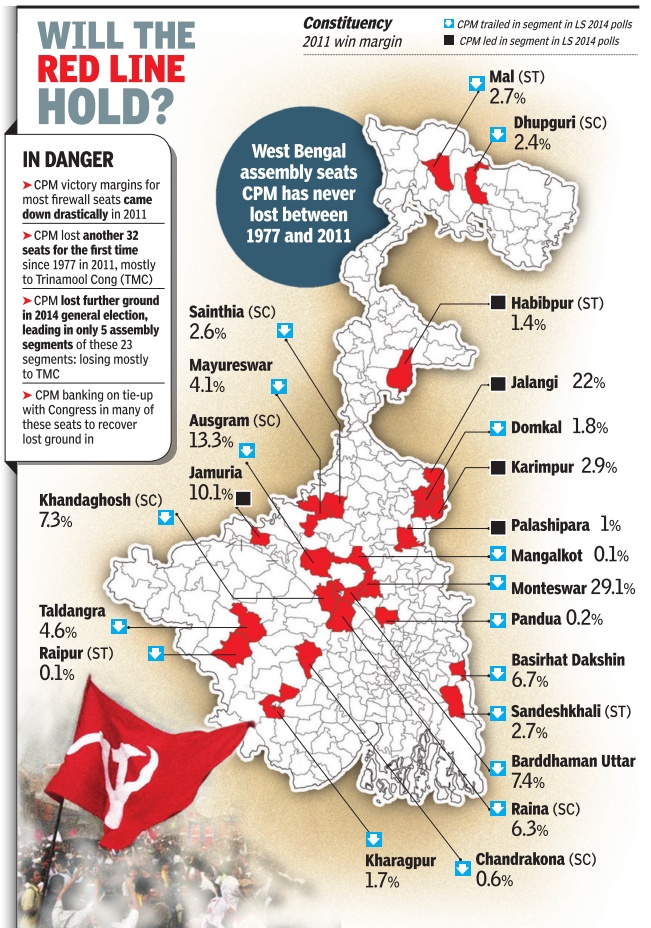
The 23 seats in Bengal CPM's never lost since 1977 hold key to its comeback run
Nalin Mehta
In 2016, as it struggles to regain lost ground in alliance with Congress, the party's real challenge is to hold on to these 23 seats. A TOI analysis shows that in nine south-central districts the CPM appears to be well entrenched. The party's problem, though, is that while in 2011 it held on to these constituencies in the face of a TMC tsunami, its victory margins were drastically down to under 10% in one-third of these 23 seats.
Before 2011, delimitation changed the contours of these constituencies, and CPM barely scraped through in most of them.
Things got worse in the 2014 LS polls.The party had leads in only 5 of these 23 assembly se g ments. While BJP won a lifetime high of 16.8% vote share in that elec tion, it was the TMC that beat the Left in these seg ments. Even more worrying was the TMC's high leads in these areas: In many cases more than 20,000 votes. These losses partly explain why the CPM went ahead with a seats deal with the Congress, which retains small pockets of influence, like in Malda and Murshidabad.
As CPM state secretary and party's chief ministerial candidate, Surjya Kanta Mishra has argued the alliance happened “spontaneously“ and the “initiative came from us“. For the Left Front, whose vote share in Bengal fell from 48.4% in 2006 to 39.1% in 2011, Bengal 2016 is crucial for its survival.
Looking at the geographical spread of the CPM wall, what stands out is its spread from Jalpaiguri (2 seats) in the north to Barddhaman (7 seats) in central Bengal to Pashchim Medinipur (2 seats) and North 24-Paraganas (2 seats) in the south.
Along with another 32 assembly seats it lost for the first time since 1977 in 2011, these 23 remain pivotal for the Left's fortunes and it is banking on them to recover lost ground.
1977-2011, seats: RSP and AIFB
See graphic

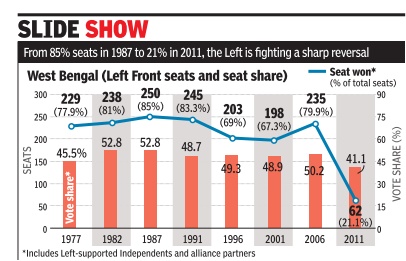

Graphic courtesy: The Times of India, April 22, 2016
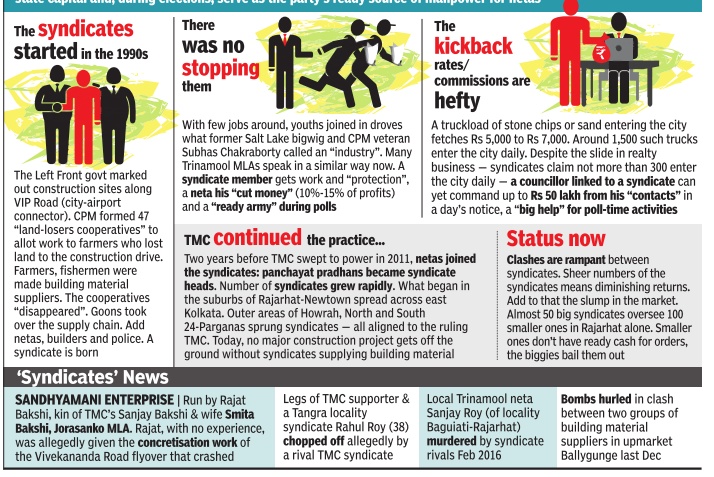
Graphic courtesy: The Times of India, April 5, 2016
See graphics
Vote shares of major parties, West Bengal, 2011-14
Kolkata’s notorious `syndicates' (a politician-builder-goon nexus) that run the booming construction materials supply chain in the state capital
2016
Overview

Graphic courtesy: The Times of India, April 20, 2016
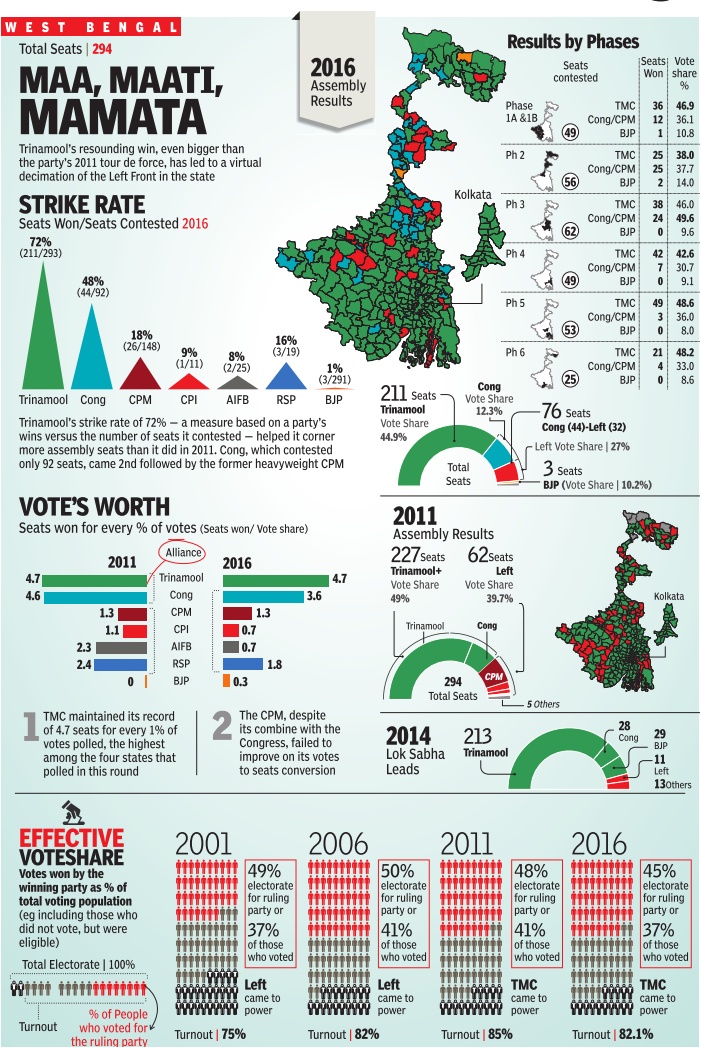
Graphic courtesy: The Times of India, May 20, 2016

Graphic courtesy: The Times of India, April 21, 2016
See graphics
Leads in Lok Sabha 2014 in assembly segments of Kolkata and its neighbourhood. (‘This time’ refers to the 2016 assembly elections)
West Bengal, assembly elections 2016: Some factual information;
Enclaves along India-Bangladesh International Border, West Bengal;
Congress improves
The Times of India, May 20 2016
Cong holds its ground, is main oppn in assembly
Mamata Banerjee may call Congress a “mere signboard“, but she will have to concede her allyturned-rival the opposition status in Bengal assembly . Congress has survived Trinamool's tsunami and not only added two seats to take its tally to 44, but also increased its vote share from 9.6% to 12%. “We will be the main opposition in the Bengal assembly after 15 years,“ Manas Bhuniya, one of the last Congress functionaries to join the jote, said after a thumping win from Sabang.
But the biggest challenge for PCC president Adhir Chowdhury will be to retain the opposition seat count.“The two parties are ideologically similar. If offered olive branches, the MLAs will be only too keen to join Trinamool, like they did after Tri namool and Congress annulled their alliance in September 2012,“ psephologist Biswanath Chakraborty said.
Congress' fortunes have been slipping ever since its chief minister, Siddharth Shankar Ray , lost in 1977. But things turned worse after 2011, with Trinamool repeatedly poaching its workers and Congress legislators switch ing allegiance and cross-voting in the Rajya Sabha polls.
To stop a repeat of the 15th assembly , Congress must keep its MLAs politically engaged. A functionary at Bidhan Bhavan admitted as much: “We are waiting for the state chief 's signal to form a roadmap for anti-Trinamool agitation programmes for next year's panchayat polls.“
CPM/ Left becomes no.3
The Times of India, May 20 2016
Five years after 2011 when it was voted out of power, the Left Front lost its main Opposition status in the 2016 assembly polls. There are clear indications that the Left--particularly CPM--has suffered a massive slide, a trend that began with the 2008 panchayat polls.
The Left is now relegated to third place after the Congress, its jote (coalition) partner.
Knives are out for CPM state secretary Surjya Kanta Mishra for entering into a “suicidal jote“ with Congress.Since a substantial section of the CPM was averse to the alliance, unpleasant questions are sure to come up in the CPM state committee meeting on Saturday .
Provisional vote share figures bear out the Left Front's downward spiral from 40.42% in the 2011 assembly polls--which it lost very badly--to 29% in the 2014 Lok Sabha polls, and now a mere 25.8% in the 2016 assembly polls. Its seat share has increased slightly from 27% in the assembly segment-wise results in 2014, but this is far less than Congress' performance as jote partner. CPM leader Mohammed Salim said that a section of Congress voters didn't vote for Left candidates.“It appears that people did not accept this jote,“ the CPM MP acknowledged. In perhaps the most stun ning blow, CPM state secretary Surjya Kanta Mishra--one of the driving forces of the jote--lost in his home turf of Narayangarh. Only a handful of winners--such as Sujan Chakrabarty , Asoke Bhattacharya, Tanmoy Bhattacharya--survived to defend the Left in the assembly .
Kolkata: 31|34 for TMC, with reduced margins
The Times of India, May 20 2016
The Trinamool Congress virtually swept through Kolkata and its suburbs. Of the 34 seats in Kolkata and urban belts of North 24-Parganas, South 24Parganas and Howrah, the party won all but three seats.
However, the dominance of TMC -it won all 11 Kolkata urban assembly seats -was tempered by a slide in the victory margin in a many seats, including that of CM Mamata Banerjee. Mamata retained Bhowanipur, that she had won by 54,000 votes in 2011, by a margin of around 25,000 votes -a reduction of nearly 50%. Ministers like Amit Mitra, Subrata Mukherjee, Sashi Panja, Javed Khan, Partha Chatterjee, Bratya Basu and Sadhan Pande saw fat victory margins turn slim as did mayor Sovon Chatterjee.
The slide in victory margins also reflected the dis quiet among a section of urban voters over issues like corruption and syndicate raj. When asked about the Saradha scam and Narada sting, Mamata said, “There's no corruption in Trinamoool.“ The issue certainly did not make any dent in the party's tally. But Madan Mitra, who had the dubious distinction of becoming the first candidate in Bengal to contest the polls from behind bars, lost. In Jorasanko, where the Vivekananda flyover collapse became a major talking point, Smita Baksi did win but her margin was pared by 25,000 votes.
Candidates who figured in the Narada sting did win, but the victories were far from convincing. In Ballygunge, Subrata Mukherjee's margin was down by 26,000 votes. Mayor Sovon Chatterjee, who had a margin of 48,173 votes in 2011, has won by 16,658 votes this time. Partha Chatterjee, whose image took a beating over allegations over his PhD, saw the winning margin for the Behala West seat crash by 50,000 votes. The syndicate effect appeared to have played its part, reducing the victory margins of canddates in the northern belt.
2021
May 3, 2021: The Times of India
Bengal Halts Sangh, Lets Daughter Fly
Didi Storms To Big Win; BJP Becomes Main Oppn
Kolkata:
Mamata Banerjee won the most important match of her life as Bengal’s voters reposed their faith in their “nijer meye (own daughter)” and propelled her to office for a third straight term. Her party, Trinamool Congress, comfortably went past the two-thirds mark in the 294-seat assembly, leading in 214 constituencies till late on Sunday evening and bagging an unprecedented 48% of the popular vote.
The victory, however, was rendered somewhat bittersweet by a narrow defeat for Mamata in Nandigram. The Election Commission website declared BJP candidate Suvendu Adhikari the winner by 1,956 votes around 11pm after a cliffhanger of a day.
That was, however, the only spot on a resounding Trinamool victory. BJP officially became the state’s main opposition party but finished a distant second despite making significant gains. The party led in 76 seats at the time of writing this report — up sharply from 3 in 2016 — and netting 38.1% of the vote. The 2021 Bengal assembly poll result also confirmed the terminal decline of the Left Front and Congress; their combined vote share was a little more than 8% and neither led in a single constituency (as of midnight on Sunday).
This would be the first time CPM would be drawing a blank since 1967 when it first fought an election in Bengal after its split from the Communist Party of India. It would also be the first time Congress would not have a seat in the state assembly. Their poll partner, the Indian Secular Front, won a seat but its share of the popular vote could not be confirmed. Ultimately, the 2021 assembly poll completed a process of churning within the opposition space, but not in Bengal. The assembly poll result may have repercussions beyond Bengal. Mamata would be looking to consolidate her gains in Bengal by getting together all anti-BJP forces and may become a rallying point for the opposition for the 2024 LS poll; she indicated as much towards the end of her campaign. Crucially for BJP, it may miss being in office in a state that sends a substantial chunk of 42 MPs to the LS.
Trinamool’s 4% increase in vote share from the 2019 Lok Sabha poll (when it got 43.6% of votes) coincided with a 2% dip in the BJP’s share of votes (from its 2019 share of 40.6%). What would have also buoyed the Trinamool was a consolidation of anti-BJP and minority votes in its favour, which would explain Congress and the LF’s decimation.
The flurry of peoplefriendly schemes, like Duare Sarkar, Khadya Sathi and Swasthya Sathi, and the schemes targeted at women like Kanyashree, also proved critical for Trinamool. The party put its best face forward — a CM in a wheelchair with an injured foot, with the catchy “Bangla nijer meyekeyi chay (Bengal wants its daughter)” slogan — as BJP struggled to get a decent local face to counter her. Trinamool made strong recoveries in pockets of North 24-Parganas, Hooghly and Howrah. It also held on to its bastions in and around Kolkata as well as those in South 24-Parganas, East Midnapore and East Burdwan, helping it lead in more than 200 seats.
BJP’s attempts at polarising helped it hold on to some north Bengal districts like Coochbehar, Jalpaiguri and Alipurduar. But its failure to counter Mamata’s “anti-outsider” slogan — used against the frequent visits of PM Narendra Modi and home minister Amit Shah — and her portrayal of BJP as a party overly dependent on “outside support (of leaders from other state)” became a handicap.
BJP might have also believed too much in defectors. Adhikari himself may be set for a narrow win but failed to deliver his own district, East Midnapore; Trinamool led in 10 of the district’s 16 seats.
TMC wins 33 of 56 seats around Nandigram
May 4, 2021: The Times of India
Mamata Banerjee may seem to have miscalculated in contesting from Nandigram, but a closer look at vote shares in the Jangal Mahal-Medinipur region of West Bengal suggests it’s actually a gamble that paid off handsomely. The region, which encompasses five districts and 56 seats, was one of only two in which the BJP had a higher vote share and led in more assembly segments than the Trinamool in the 2019 Lok Sabha polls — north Bengal being the other.
In 2019, BJP led in 32 of the 56 segments and had a vote share of 44.8% to TMC’s 43.3. When Suvendu Adhikari, Trinamool’s erstwhile strongman in this region, switched sides to join BJP, it looked very possible that the gap could widen even further. Yet, TMC has actually turned the tables to win 33 seats here and pick up a vote share of 46.1%, significantly higher than BJP’s 43.7%. The confidence shown by Mamata’s decision to contest from the home turf of the Adhikaris appears to have helped in this turnaround. TNN
BJP did far better in SC/ST seats than in general
May 4, 2021: The Times of India
Trinamool has won almost three-fourths of the seats in the Bengal assembly, but its showing in reserved seats demonstrates BJP’s attempts at social engineering were successful to a considerable extent. The 84 reserved seats – 68 for SC and 16 for ST – saw a much closer contest between the two rivals in terms of seats won as well as vote shares than the general seats.
TMC won 45 of the reserved seats, BJP 39. Thus, TMC had just 15% more reserved seats than BJP. In general seats, TMC’s tally of 169 was four and a half times as much as BJP’s 38. The gap in vote share between the two in general seats was 13 percentage points – 49.2% against 36.2%. In the seats reserved for SC, that narrowed to under four percentage points with TMC getting 46.2% and BJP 42.8%. In ST seats, the gap was narrower, TMC’s share being 45.2% and BJP’s 44%.
The good news for TMC is in both SC and ST seats, its performance improved upon the 2019 showing, when the BJP had led in 46 segments and the TMC in just 37. TNN
Seats that changed hands
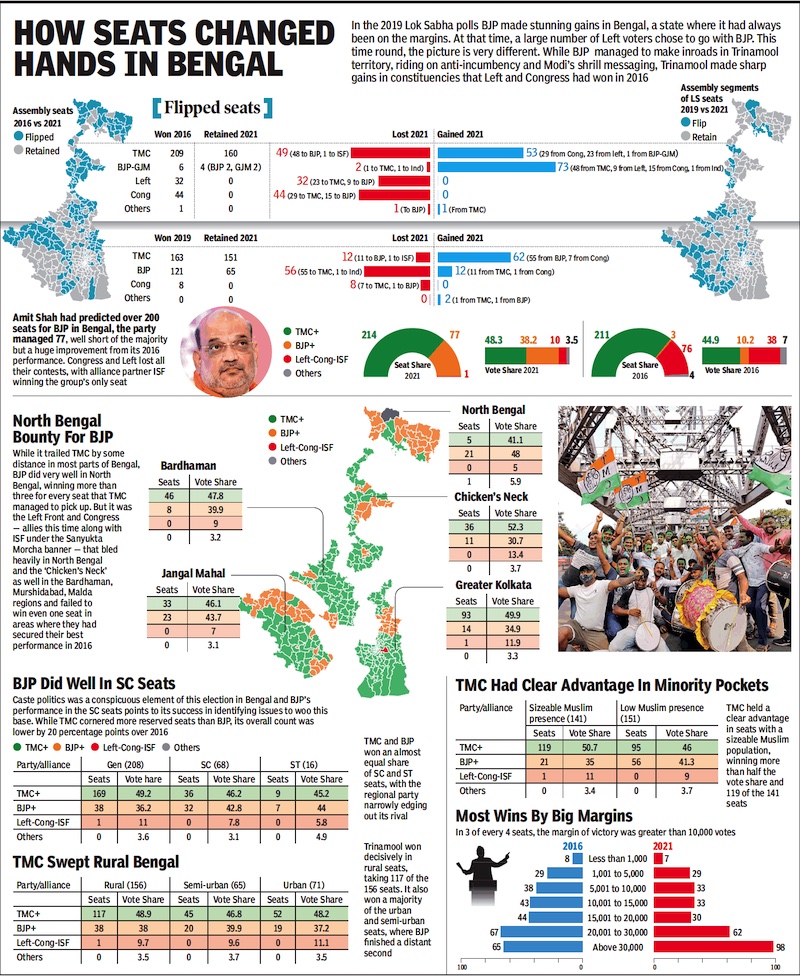
From: May 4, 2021: The Times of India
See graphic:
2021: Assembly seats that changed hands in Bengal
TMC wins 2/3 majority
See graphic:
West Bengal Assembly elections, 2021
Kolkata votes for TMC
Dwaipayan Ghosh & Tamaghna Banerjee, May 3, 2021: The Times of India
Kolkata's faith in Trinamool Congress remained unshaken in a makeor-break assembly election for Mamata Banerjee, with the party making a clean sweep of all 16 assembly seats up for grabs. Wresting the Jadavpur seat from the Left Front — the only one it hadn't won in 2016 — made the victory sweeter.
The only scare came in central Kolkata's Jorasanko, where BJP candidate Meena Devi Purohit led Vivek Gupta of TMC for several rounds before the latter surged ahead. TMC had trailed BJP there in the Lok Sabha polls two years ago.
Rashbehari, another TMC bastion that was jolted in the 2019 Lok Sabha polls, kept the party on tenterhooks for most part of the morning before TMC candidate and former mayor-in-council Debasish Kumar opened up a lead against BJP's Subrata Saha.
Two-time MLA Arup Biswas, who defeated Union minister Babul Supriyo in Tollygunge by his biggest-ever margin of 50,000-odd votes, dared his rival to try his luck again in the municipal polls.
In Jadavpur, where CPM veteran Sujan Chakraborty had lost to TMC’s Debabrata Majumdar, the contest was onesided. Rinku Naskar, the CPM-turned-BJP candidate, unwittingly helped TMC's cause by grabbing a 26 per cent vote share to push Chakraborty to the third spot.
TMC continued its dominance in Behala with bold bets, including fielding Ratna Chatterjee, the estranged wife of former mayor Sovan Chatterjee, in Behala East. TMC's performance in North Kolkata would have given it the most satisfaction. The party had trailed in Shyampukur in the 2019 Lok Sabha elections and led by only 861 votes at Maniktala.
“The onus is on the new government to restore normalcy, and the path will not be easy. We have to begin fighting Covid from the beginning,” said minister Firhad Hakim, who won the Kolkata Port seat.
Why TMC won
Kumar Shakti Shekhar, May 2, 2021: The Times of India

From: May 3, 2021: The Times of India
See graphic:
What worked for the TMC in 2021 and what did not for the BJP
NEW DELHI: West Bengal chief minister Mamata Banerjee-led Trinamool Congress (TMC) on Sunday registered a third consecutive victory in the state assembly election.
Mamata, the TMC supremo, successfully took on the BJP juggernaut led by Prime Minister Narendra Modi and home minister Amit Shah besides a battery of national and state leaders.
Though the BJP had set a target of winning more than 200 of the 292 seats which went to polls, it was the TMC instead which crossed the double century mark. In the process, the BJP got restricted to double digit figures.
These are seven reasons why Mamata-led TMC won the 2021 West Bengal assembly election:
1. Women
The BJP had hoped to get votes of women on the basis of the several initiatives that the Modi government at the Centre has taken for them in the last six-seven years such as building toilets, giving LPG connection, promising to give tapped water in every household and the likes. However, election after election, the women have stood solidly behind Mamata who also implemented several welfare measures for them. Her refrain in this election was that she herself is a female and a “daughter of Bengal”.
West Bengal has 3.7 crore women voters who constitute 49 per cent of the electorate. Mamata has implemented about 200 women-centric schemes such as Kanyashree and Rupashree which grant funds for education and marriage, Sabooj Sathi which gives bicycles for girl students and education loans.
In this year’s election manifesto, the TMC had promised free delivery of ration at the doorstep It has also promised the implementation of a ‘Monthly Basic Income’ scheme under which the “women heads of families” will be entitled to a stipend of Rs 500-1000 per month.
The TMC earned the dividend for launching women-centric schemes. In the 2016 assembly election, 52 per cent of its votes is believed to have come from women. The same trend was witnessed in the 2019 Lok Sabha election when the BJP won 18 and the TMC 22 of the 42 seats. Then, 51 per cent of the TMC’s votes came from women.
The BJP considered the women as “silent voters”. But they have chosen to vote for Didi.
2. Muslims
Muslims constitute about 30 per cent of West Bengal’s population and their votes are decisive in 100-110 of the 294 assembly seats, situated mostly in the districts of Kolkata, Murshidabad, Malda, and North and South Dinajpur. Since the 2011 assembly election, they have voted for the TMC.
The TMC had retained office in 2016 by winning 204 assembly constituencies with the crucial help of these Muslim-dominated seats. Ever since Mamata Banerjee came to office in her first stint in 2011, she has been wooing the Muslims by announcing several sops for them.
For instance, her TMC government gave a monthly stipend of upto Rs 2,500 to about 60,000 imams and muezzins, distributed bicycles to girl students enrolled in madrassas, extended scholarships to Muslim students of Class I to X, offered reservation to Muslim OBCs and has declared Urdu as the second language in the Muslim-populated districts.
Besides these, her government had banned a TV serial scripted by activist Taslima Nasreen in December 2013 after Muslim fundamentalists objected to it. The Mamata government had also put restrictions on Saraswati Puja celebrations and immersion of Goddess Durga idols.
Due to her Muslim appeasement, she is often taunted by being called “Mumtaz Begum”.
However, her Muslim votebank appeared to be threatened in this election with the entry of the head of the popular shrine of Furfura Sharif in Hooghly district Pirzada Abbas Siddiqui-led Indian Secular Front (ISF) and All India Majlis-e-Ittehadul Muslimeen (AIMIM) chief Asaduddin Owaisi. ISF tied up with the Congress and the Left as a Sanyukt Morcha.
But the Muslims seem to have voted en bloc for the TMC.
3. BJP’s failed counter-polarisation
The BJP’s attempts at counter-polarisation of Hindu votes appear to have helped it only to a small extent. The BJP’s efforts to woo the Scheduled Castes (SCs) and Scheduled Tribes (STs) also did not pay rich dividends.
The PM went to Bangladesh on March 26 on a two-day visit at the invitation of his counterpart Sheikh Hasina for the twin occasions of the neighbouring country’s 50 years of nationhood and the centenary of Bangabandhu Mujibur Rahman.
On March 27, the day West Bengal faced first of the eight phases of elections, he visited Orakandi, a small town in Gopalganj which is considered to be the cradle of the Matua Mahasangha. It is the birthplace of Matua sect founder Harichand Thakur. He delivered a speech after offering prayers at the Orakandi Temple.
The Matua Mahasangha was founded around 1860 in Orakandi in Bangladesh. A sizeable number of Matuas migrated to West Bengal during the 1947 partition. The next lot came during the 1971 war and the creation of Bangladesh.
Matuas are a sect of Vaishnavite Hindus and belong to the SC category. Around three crore Matuas are settled around the Thakurnagar area of North and South 24 Parganas and Nadia. Believed to vote en bloc, they are dominant in about 35 assembly seats in these districts.
Till the 2019 Lok Sabha elections, the Matuas voted for Mamata. However, Shantanu Thakur of the BJP won the Bongaon seat in 2019, defeating Mamata Bala of the TMC. The BJP led in nearly 20 of the 35 assembly segments with a significant Matua population in the 2019 Lok Sabha elections.
Shantanu’s brother Subrata Thakur was the BJP candidate from Gaighata assembly constituency. Shantanu accompanied PM Modi to Orakandi.
Prime Minister Modi’s visit to Bangladesh failed to consolidate the Hindu voters in general who have migrated from the neighbouring country and the Matuas in particular favour of the BJP.
4. Last 3 phases of election
The West Bengal election, which started on March 27, saw aggressive campaigning by both the TMC and the BJP in the first five phases which got over on April 17. The BJP fielded Modi, Shah, party president JP Nadda, Uttar Pradesh chief minister Adityanath Yogi and several Union ministers among others.
However, the second wave of the COVID-19 hit the country in the second week of April. The BJP star campaigners including Modi and Shah either cancelled their public rallies or held virtual rallies in the last three phases of voting which were held on April 22, 26 and 29. But Mamata continued with her public rallies till the last phase of election. She seems to have taken an edge over the BJP by holding rallies till the last phase of election.
5. Congress walkover
The Congress’s top two leaders - Rahul Gandhi and Priyanka Gandhi Vadra - kept away from most parts of the West Bengal elections. While Priyanka never campaigned in the state, Rahul held public rallies only on April 14, ahead of the fifth phase of the election which was held on April 17.
On April 18, he announced cancellation of other public meetings. Two days later on April 20, it was announced that he had tested positive for COVID-19.
With the Nehru-Gandhis almost keeping away from campaigning, they gave a walkover to the TMC. The anti-TMC votes did not split as much as it would have, had the Congress remained in the fray with gusto. It helped Mamata in a major way.
BJP general secretary in charge of Kailash Vijavaygiya accused the Congress and the Left of “surrendering” before the TMC. “The Left and Congress surrendered to help the TMC win,” he said.
6. COVID-19
A major part of the blame for the second wave of COVID-19 was being heaped on Modi and the BJP-led central government.
The BJP failed to counter the allegations against the Modi government of having messed up in handling the COVID-19 situation which saw a record number of people getting infected and dying due to the scarcity of hospital beds and oxygen.
This proved to be bad publicity against the BJP and it played a role in the BJP’s defeat in West Bengal.
7. Sympathy for Mamata
Mamata Banerjee apparently succeeded in winning the sympathy of the voters on several counts. She was seen as a lonely woman taking on the aggressive campaign of the BJP led by Modi and Shah. Secondly, Mamata’s attack on the BJP as a party being led by “outsiders” also seems to have worked in her favour.
Bihar chief minister Nitish Kumar had benefitted from a similar situation in the 2015 state assembly election when Modi and Shah had led an aggressive campaign against the JD(U) leader. The Mahagathbandhan (Grand Alliance) comprising JD(U), RJD and the Congress had trounced the BJP.
PM Modi’s “Didi, o Didi” jibe at Mamata seems to have helped the latter as she alone has succeeded in defeating the BJP.
Secondly, Mamata’s fractured leg also has helped her gain sympathy from the voters. She sustained injuries to her left leg and waist on March 10, the day she filed her nomination for election from Nandigram. She was admitted to SSKM hospital in Kolkata. She was discharged from the hospital on March 12.
While she tried to draw as much sympathy as possible from the powerful imagery of campaigning on a wheelchair with the plastered leg, the BJP made all efforts to ensure that she did not derive political mileage out of the incident.
The whole exercise of the TMC and the BJP involving Mamata’s leg injury revolved around cut-throat vote bank politics. The TMC claimed that the “attack was a deep-rooted conspiracy to take the life of the TMC supremo". It accused the BJP of mobilising anti-social elements from the neighbouring states in Nandigram to unleash violence.
The BJP was quick to react lest Mamata won sympathy for the incident. It called the incident an accident and quoted few “eye-witnesses” to buttress its argument. A BJP delegation also met the Election Commission on March 12 besides addressing a letter to the poll body.